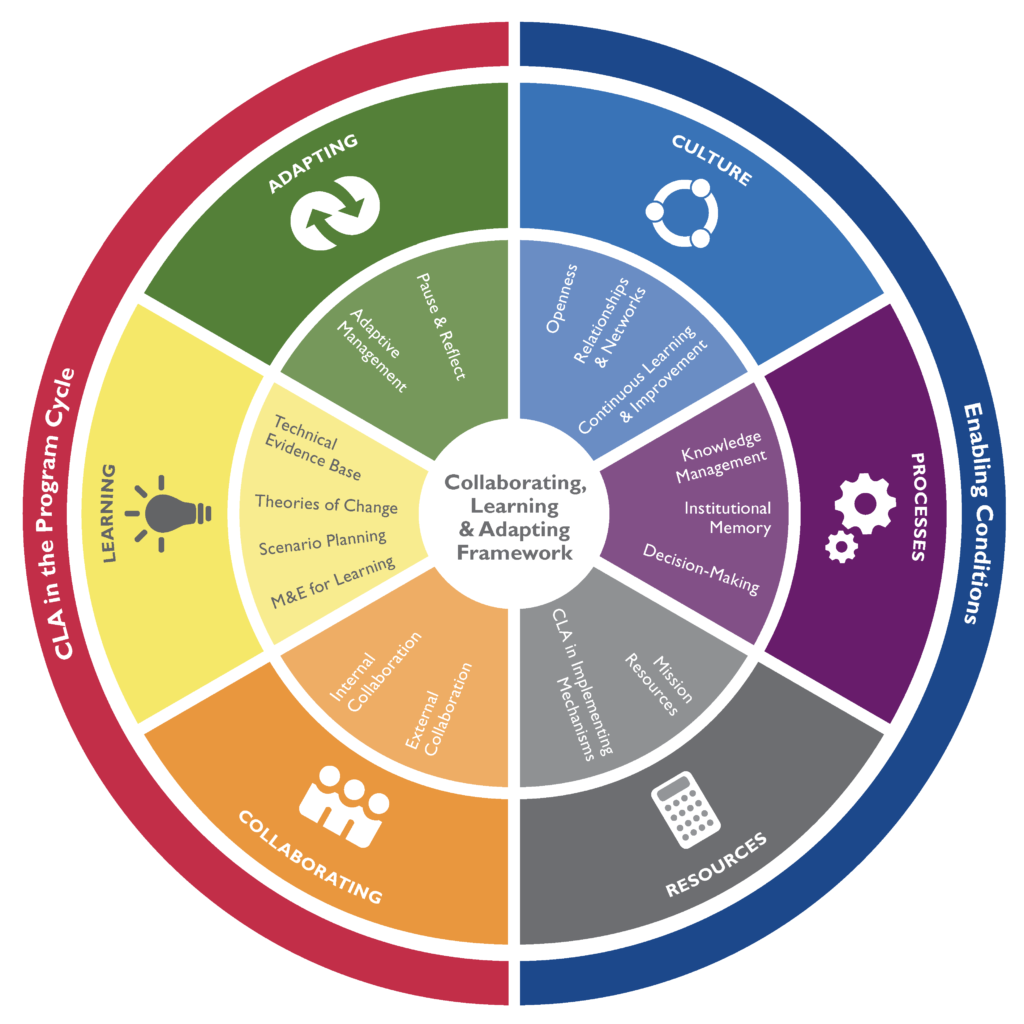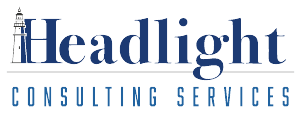By Georgia Handforth, CLAME Associate, Headlight Consulting Services, LLC
This blog is the first of a three-part mini-series on organizational learning and the Collaborating, Learning, and Adapting (CLA) Framework.
Here at Headlight—and for many of our partners and peers—we spend our days digging into development work that is evidence-based, systems-aware, and locally-led. While most people would probably agree that collaborating strategically, learning intentionally, and adapting based on evidence are useful skills, for us those skills are at the core of our approach to tackling organizational strategy, Monitoring and Evaluation (M&E), and so much more. That’s why we have embraced the Collaborating, Learning, and Adapting (CLA) Framework to organize our thinking about what really makes up effective organizational learning practice: making it systematic, intentional, and resourced.
This blog is the first of a three-part mini-series on the value we see in CLA, and approaches that we have found work well for us and for others to implement and improve CLA practice. In this post, we’ll cover the CLA Framework, and how to get started approaching or improving CLA for your team. The second and third posts will cover two specific tools we find useful for building successful CLA practice, how we get feedback on our CLA trainings, and aspects of CLA our team wish more people knew about.
Quick Look: How does CLA relate to Monitoring and Evaluation (M&E)?
Looking at the CLA Framework graphic below, or if you’ve encountered it before, one reasonable question might be ”I do a lot of information gathering in my M&E work already, and I collaborate with others. What is this CLA Framework, and how does it relate to the work I already do?”
The relationship between CLA and M&E could be a blog post all it’s own, but here are a few thoughts from Headlight staff:
“CLA is how we ‘action’ M&E. M&E has a use but isn’t living up to its full potential if we are not sharing the results with stakeholders, learning from them, and making adaptations based off that.”
“CLA is to M&E as a park is to a field. CLA is an entire park… and M&E is more specific, like a [sports] field, with boundaries.”
“I like to think of CLA as the umbrella and M&E activities fall under that, it is all an approach to building a learning organization that tracks performance, evaluates to learn the reasons why things are going well or not, and adapts accordingly.”
“CLA is to M&E as nutrition is to cooking.”
The CLA Framework
Before diving into the CLA Framework, it is worth noting that this is one way of organizing thinking about organizational learning and effectiveness. There are others! We would much rather see strong practices across a team, that support learning and adapting based on evidence, than live in a world where CLA language is common but seen as just another box to check. Where the Framework is most helpful is in seeing CLA as a holistic approach, rather than a collection of skills and best practices. As we’ll discuss in our second post of this series, drawing out the connections points and feedback loops among the sub-components of the CLA Framework orients a team to what is going well and what areas are poised to get even stronger.
First, we have to introduce the CLA Framework:
The CLA Framework consists of 6 components and 16 sub-components. The framework and many supporting materials were developed by USAID to support better development results—see this two-pager for an overview of the CLA Framework and each subcomponent.
Below is an image of the CLA Framework, where each colored “wedge” represents one of the six components and contains between two and four subcomponents. Notice how the left-hand elements of Collaborating, Learning, and Adapting are only half of the puzzle: they have to be supported by enabling Culture, Process, and Resources.

Making CLA work for you
How can an individual or a team take this tidy framework and graphic and connect it back to the messy everyday realities of working in complex contexts, as part of busy teams, with many competing priorities?
The first thing to assess is:
How do existing practices, norms, and procedures in your organization or team already map onto the different subcomponents of the framework?
The secret is that most teams already do a lot of the things represented on the CLA Framework, and may already have strong practices and norms in key areas. The real difference is taking an approach that is systematic, intentional, and resourced.
For instance, every work context involves Relationships and Networks, and many different teams take Pause and Reflect opportunities and steward Institutional Memory in some form. The second blog in this three-part series (stay tuned!) will share about an exercise we’ve found extremely useful to help a team to reflect on existing CLA practices, and then take it a step further by seeing connections among CLA subcomponents, as the team is already enacting them. This can be a great springboard for strengthening or building up CLA practice: instead of starting from scratch and focusing on what is missing, you have the opportunity to take a strengths-based perspective and start by reflecting on what is already going well.
At the same time that you highlight your existing strengths, you also have the opportunity to see areas with room for growth. The other exercise we’ll cover in our second blog on CLA is a tool that helps teams assess and prioritize CLA practices, and think through concrete steps toward improvement. This can help stay focused on positive goals and avoid overwhelm from trying to take on too much at once.
The third and final blog post in this mini-series will go deeper into practical experiences Headlight has had implementing CLA. We will discuss our process of getting feedback to inform Decision-Making on CLA trainings we run, as well as going into more detail on the common pitfalls around CLA that Headlight staff have seen. As a bonus, drawing on our fondness for Internal Collaboration here at Headlight, in the final post we will share some favorite subcomponents and hidden gems in the framework according to Headlight staff. Remember to subscribe to this blog to catch the rest of the CLA series, and in the meantime check out the additional resources linked below for more on how to use CLA.
For more information and resources on CLA:
The USAID Learning Lab CLA Toolkit
USAID CLA Example Cases (CLA Case Competition)
Headlight’s Pause and Reflect Guide
If you have any questions about organizational development and learning or would like help assessing or improving your CLA capacity, Headlight would love to support you! We have the breadth and depth of experience to tailor-meet your needs.
For more information about our services, please email info@headlightconsultingservices.org.
Headlight is a certified woman-owned small business and therefore eligible for sole source procurements. We can be found on the Dynamic Small Business Search or on SAM.gov via our name or DUNS number (081332548).





Comments
no comments found.